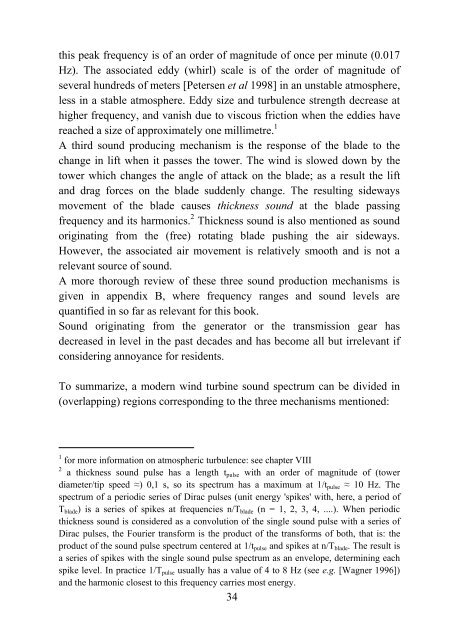The sounds of high winds
The sounds of high winds
The sounds of high winds
You also want an ePaper? Increase the reach of your titles
YUMPU automatically turns print PDFs into web optimized ePapers that Google loves.
this peak frequency is <strong>of</strong> an order <strong>of</strong> magnitude <strong>of</strong> once per minute (0.017<br />
Hz). <strong>The</strong> associated eddy (whirl) scale is <strong>of</strong> the order <strong>of</strong> magnitude <strong>of</strong><br />
several hundreds <strong>of</strong> meters [Petersen et al 1998] in an unstable atmosphere,<br />
less in a stable atmosphere. Eddy size and turbulence strength decrease at<br />
<strong>high</strong>er frequency, and vanish due to viscous friction when the eddies have<br />
reached a size <strong>of</strong> approximately one millimetre. 1<br />
A third sound producing mechanism is the response <strong>of</strong> the blade to the<br />
change in lift when it passes the tower. <strong>The</strong> wind is slowed down by the<br />
tower which changes the angle <strong>of</strong> attack on the blade; as a result the lift<br />
and drag forces on the blade suddenly change. <strong>The</strong> resulting sideways<br />
movement <strong>of</strong> the blade causes thickness sound at the blade passing<br />
frequency and its harmonics. 2 Thickness sound is also mentioned as sound<br />
originating from the (free) rotating blade pushing the air sideways.<br />
However, the associated air movement is relatively smooth and is not a<br />
relevant source <strong>of</strong> sound.<br />
A more thorough review <strong>of</strong> these three sound production mechanisms is<br />
given in appendix B, where frequency ranges and sound levels are<br />
quantified in so far as relevant for this book.<br />
Sound originating from the generator or the transmission gear has<br />
decreased in level in the past decades and has become all but irrelevant if<br />
considering annoyance for residents.<br />
To summarize, a modern wind turbine sound spectrum can be divided in<br />
(overlapping) regions corresponding to the three mechanisms mentioned:<br />
1 for more information on atmospheric turbulence: see chapter VIII<br />
2 a thickness sound pulse has a length t pulse with an order <strong>of</strong> magnitude <strong>of</strong> (tower<br />
diameter/tip speed ) 0,1 s, so its spectrum has a maximum at 1/t pulse 10 Hz. <strong>The</strong><br />
spectrum <strong>of</strong> a periodic series <strong>of</strong> Dirac pulses (unit energy 'spikes' with, here, a period <strong>of</strong><br />
T blade ) is a series <strong>of</strong> spikes at frequencies n/T blade (n = 1, 2, 3, 4, ....). When periodic<br />
thickness sound is considered as a convolution <strong>of</strong> the single sound pulse with a series <strong>of</strong><br />
Dirac pulses, the Fourier transform is the product <strong>of</strong> the transforms <strong>of</strong> both, that is: the<br />
product <strong>of</strong> the sound pulse spectrum centered at 1/t pulse and spikes at n/T blade . <strong>The</strong> result is<br />
a series <strong>of</strong> spikes with the single sound pulse spectrum as an envelope, determining each<br />
spike level. In practice 1/T pulse usually has a value <strong>of</strong> 4 to 8 Hz (see e.g. [Wagner 1996])<br />
and the harmonic closest to this frequency carries most energy.<br />
34
















